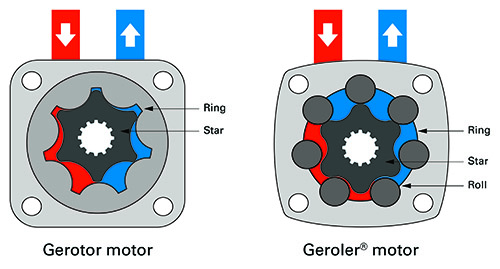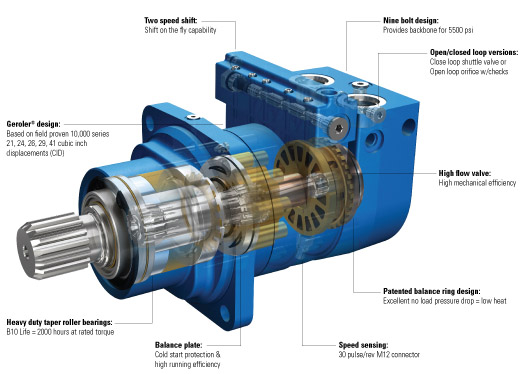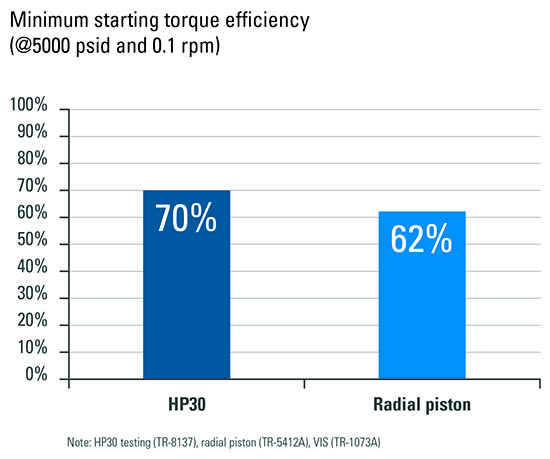When selecting a gerotor motor, there are many items to consider, including performance, quality, reliability and cost. Choosing the wrong one could lead you down a path of frustration. Before selecting your motor, let’s discuss the basics of gerotor motors.
 The gerotor motor, or generated rotor motor, has been around for decades. In fact, the first gerotor motor in Eaton’s portfolio was manufactured more than 65 years ago. Soon after, the company invented the Geroler motor to meet the needs of the market and improve upon performance and reliability.
The gerotor motor, or generated rotor motor, has been around for decades. In fact, the first gerotor motor in Eaton’s portfolio was manufactured more than 65 years ago. Soon after, the company invented the Geroler motor to meet the needs of the market and improve upon performance and reliability.
These two motor types use what is termed as the orbit principle, which is what gives the motors their tremendous power density and compact size. A gerotor motor star has six teeth and seven lobes. The spaces among them are pressure chambers. Pumped fluid flows into these pockets, creating high pressure in one chamber and low pressure in another. This creates an imbalance of forces, which causes the gerotor motor star to rotate, or orbit. A gerotor motor star orbits multiple times, Figure 1, typically six to eight times depending on the specific star and ring geometry—for each complete single revolution within the outer ring. Geroler motors use the gerotor principle, but use rollers instead of lobes. This reduces friction and wear—and improves low-speed performance, extending the motor’s life.
Gerotor and Geroler motors deliver from 10 to 50,000 in.-lb of torque and can operate at speeds up to 2,000 rpm. Because of their simple design and compact size, they can be used in both mobile and industrial applications. However, they are well-suited for mobile applications—especially agriculture, material handling and construction—because of their incredible power density.
 The speed and torque requirements of the application will determine the size of motor. This will point users into what displacement (how much fluid is needed to turn one revolution) is needed. Speed and torque can be determined with the following basic motor equations. These are the starting points for finding the properly sized motor.
The speed and torque requirements of the application will determine the size of motor. This will point users into what displacement (how much fluid is needed to turn one revolution) is needed. Speed and torque can be determined with the following basic motor equations. These are the starting points for finding the properly sized motor.
Theoretical torque (in.-lbs) = in.3/rev x pressure differential/(2Pi)
Theoretical speed (rpm) = gpm x 231 / in.3/rev
Here are five things to consider when deciding on the right gerotor or Geroler motor for your needs:
- Performance:
– Ask for mechanical and volumetric efficiency data, and make sure the test data is over an extended period of time. Some manufacturers may tune performance to peak in the first few hours of operation, but then degrade quickly. Performance that degrades quickly will not do your machine justice.
– Compare apples to apples; hydraulic motor performance data is not standardized. Be wary of ratings and test data that do not include all of the performance test parameters.  Quality:
Quality:
– Does the manufacturer have a history of consistent quality? Ask for the quality data.
– Motor grinding is not all the same. Grinding star profiles outside the capabilities of the form grinding machine will cause inconsistent results.
– Look for high-quality materials and ensure that inferior materials (with processes like heat treating and form grinding) are not being used.
– Compare the warranty options.- Reliability:
– Reliability is quality over time. Look for a product with a track record—history is the best predictor of the future. - Support:
– Investigate the options for additional support. Would you benefit from CAD modeling support or the creation of a custom solution? Remember that this can differentiate your machine from the competitor.
– Do you just want a part or do you want a system of solutions? Some manufacturers can provide a custom system of solutions for your machine, while others specialize in providing a singular part. - Cost:
– Obviously, cost is very important, but it is really a function of all the previous items. Sacrificing the above items can provide a lower cost, but consider what will happen to your machine (and your customer) when issues arise.
– Some companies try to keep costs low by having a “one size fits all” approach to their motor portfolio. This may work for some, but make sure the solution you choose really works the way it should on your machine.
By Todd Degler, Product Manager, Eaton Hydraulic Motors
Eaton Corp.
eaton.com/Eaton/ProductsServices/Hydraulics/Motors/GerolerMotors/index.htm


We have a 2 motor in series project is currently testing our will. It is an oem project so we need to get it right. We are driving 2 metering pumps in series (adhesives). It works well at no loads, but as load increases, the first drive motor falls off about 4%. (We have digital rotation counters on motor shafts … 10 counts per revolution & recording data) The second motor has significantly less to do and appears to drive less oil thru the bearings, resulting in 4% more revolutions. Motors are 103-1005-010 Char lynn. These motors were used prior to the start of this project, Running pressure at our current full load is about 350-500 psi . Using a Parker D-Pak 1.8gpm/1hp. All these parts were pulled from our archives to create a “what if” machine. It looks promising but we have some items to improve. Any help will be appreciated. Thanks, Jerry